- Concrete Stain Home
- Get the Look - Stained Floor Pictures
- Color Chart: Concrete stain colors
- Comparison Chart: Compare acid stains, water-based stains and dyes
- Stain Buying Tips: Questions to ask before you buy
- How to Stain Concrete
- Types of Stains and Coloring Options
- Acid-Based Stains
- Water-Based Penetrating Stains
- Concrete Dyes
- Concrete Paint
- Exterior Concrete Stain: Click through images of outdoor stained concrete projects
- Stains and Equipment Product Reviews
- Troubleshooting Concrete Stains
- Common Staining Issues: Tips from expert Chris Sullivan
- Removing Stains from Concrete
New Markets for Concrete Stains
With the advent of new products and technology, the use of concrete stains is now becoming mainstreamThis is an excerpt from the new e-book “Concrete Staining Today,” part of a series of reports from ConcreteNetwork.com on trends and insights about decorative concrete applications.
Concrete Staining Today
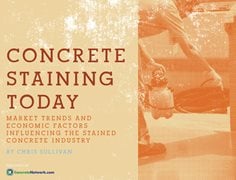
Discover four emerging trends in concrete staining from ConcreteNetwork.com’s new e-book. You’ll also get insights and advice from veteran installers that will help you stay profitable in today’s market.
Download Concrete Staining Today (PDF)
Historically, concrete stains were used on interior slabs. Most stain projects in the early days were applied to finished floors in commercial buildings, including entryways, walkways, lobbies, restaurants, and office spaces. Of course, there were some free-thinking installers who applied stains on exterior and residential concrete, but they were the minority. Fast forward to the present day, and you’ll find that concrete stains have expanded far beyond interior commercial spaces and are now commonplace in the home as well as outdoors. In fact, concrete stains are being used anywhere you have concrete.
This expansion in the applications for stains is in part due to the introduction of water-based stains and dyes that hit the market in the early 2000s. This new generation of stains offer an expanded color palette compared to traditional acid stains and are much easier and faster to install. The other major factor that has led to the expansion in the use of stains is growing awareness. Stained concrete has become a mainstream flooring option embraced by both businesses and homeowners. Designers love the versatility, and homeowners love the look and color palette as well as the ease of maintenance.
Interior concrete remains a large portion of the stained concrete market. Concrete with a hard-trowel finish that exhibits natural color variations remains the optimum surface for interior staining. While time-honored earth tones produced by acid stains are still popular, lighter colors are becoming more popular. “Softer colors are becoming popular, and the industrial look with gray and charcoal are replacing the earth tone colors,” says Dave Pettigrew, owner of Diamond D Concrete, Capitola, Calif. “Thanks to the expanded color palette of modern stains, along with the forward thinking of the design and installer communities, the interior stain market remains strong.”
Exterior concrete is a relatively new area for stains. Although stains have been used to highlight and accent exterior concrete for decades, using stains as a stand-alone coloring option for exterior concrete has become popular in only the last 5 to 10 years. Installers have become savvy over the last decade in how to finish exterior concrete so that it works with stains, and new technology has provided one-step easy-to-apply stains that come in a much larger color selection than traditional acid-based stains. When it comes to sealing exterior stain work, improvements in sealer technology along with a more educated installation community have led to fewer failures and better long-term results.
However, the extent of exterior stain use often varies by region. “We still see most of our stain work inside because of our environment,” says Greg Hyde, owner of Hyde Concrete, Annapolis, Md. He also says that the East Coast is behind Texas and California when it comes to using stains, and this area still has people who don’t get it when it comes to expanding stain use to applications other than interior floors.
One market that has actually experienced a drop-off in stain use is restaurants and food service facilities. Years of poor results in regard to aesthetics and longevity have led the design community to move away from using stains on these floors. Poor expectation management by stain manufacturers and installers and lack of proper maintenance by the food service sector are the major factors in the reduction of stain use by this market. Large companies, such as Starbucks, who once specified stained floors in many of their stores, no longer do so. Without proper maintenance, a stained floor -- no matter how well installed and sealed -- will show wear in a short time. The level and type of maintenance often depends on the amount of traffic exposure, and food service floors can be some of the most difficult to maintain because of the number of in-and-out customers, chairs and tables being moved around, and food spills. That said, some contractors are having success staining restaurant floors. Hyde says that he stains a lot of restaurant floors. He has a system that works, and he spends time educating his clients on maintenance.
Related resources: Staining Trends - Colors, applications and competition
How to Protect and Maintain Stained Concrete
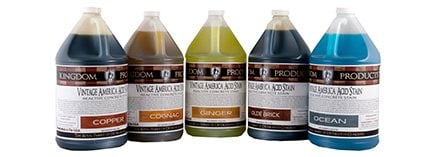 Vintage America Acid Stain
Organic, antique patina, deep penetrating reactive stain.
Vintage America Acid Stain
Organic, antique patina, deep penetrating reactive stain.
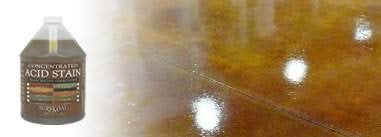 Acid Stain by Surfkoat
Makes up to 2 gallons. Great for marble look.
Acid Stain by Surfkoat
Makes up to 2 gallons. Great for marble look.
 Stain-Crete by Increte
9 standard colors. Useful for old or new concrete.
Stain-Crete by Increte
9 standard colors. Useful for old or new concrete.
 Elements® Transparent Concrete Stain
Water-based, environmentally and user-friendly
Elements® Transparent Concrete Stain
Water-based, environmentally and user-friendly
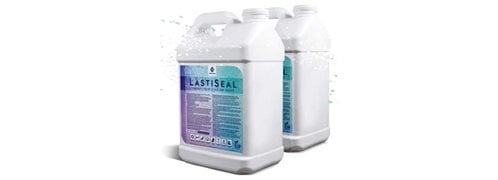 Concrete Stain + Sealer in One
Waterproof, strengthen, preserve and beautify in one step
Concrete Stain + Sealer in One
Waterproof, strengthen, preserve and beautify in one step
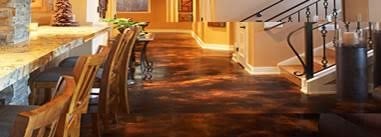 Stone Tone Stain
10 color options. Resistant to chipping and fading.
Stone Tone Stain
10 color options. Resistant to chipping and fading.
 Concrete Acid Stain
BRICKFORM Blush-Tone Acid Stain available in 10 standard colors
Concrete Acid Stain
BRICKFORM Blush-Tone Acid Stain available in 10 standard colors
 In-Fluence Water-Based Stain
24 non-reactive colors that transform concrete.
In-Fluence Water-Based Stain
24 non-reactive colors that transform concrete.




